DAY 2 (3/4): PILGRIM OASIS IN THAR DESERT, Sachiya Mata Temple, Osian, Rajasthan, India, 2018.11.25

After a quick lunch at Pal Haveli Hotel, we hopped on the prearranged car for Jaisalmer, the golden city of Rajasthan. Before reaching Jaisalmer, we made a brief stop at Osian, a desert oasis famous for its ancient temples and camel safaris. At 15:00, our driver dropped us off at a dusty street intersection in Osian. Our driver spoke no English and we didn’t have a proper map of Osian. Google Map wasn’t helpful either for locating where we were. We followed a street lined with religious and souvenir shops and hoped that it would lead us to the town centre. We soon arrived at a temple. Judging from its archways and entrance stairway, we thought it should be Sachiya Mata, the temple that we intended to visit.
Osian was sleepy and we could hardly see a tourist. Even local pilgrims were fewer than expected. Originally a popular religious and trading hub in the Thar Desert, Osian has seen better days before Muhammad of Ghor and his Turkish and Muslim armies sacked the town in 1195 CE. Today it is no more than a quiet small town 40km north of Jodhpur with a handful of ruined temples. In its heyday between the 8th and 12th century, dozens of Brahmanical and Jain temples flourished in Osian, making the town a hub for camel caravans and Hindu and Jain pilgrims.
 Built by Parmar king Upaldev for his kulderi (family deity), the Hindu mother goddess Sachiya, the Sachiya Mata Temple dated back to the 8th century.
Built by Parmar king Upaldev for his kulderi (family deity), the Hindu mother goddess Sachiya, the Sachiya Mata Temple dated back to the 8th century.
 Construction was made in different phases. The last changes were made in the 12th century.
Construction was made in different phases. The last changes were made in the 12th century.
 Today, visitors can tour around the complex, experience the sacred ambience of occasional religious ceremonies and admire the thousand year old statues and paintings.
Today, visitors can tour around the complex, experience the sacred ambience of occasional religious ceremonies and admire the thousand year old statues and paintings.
 After walking up the archways, we passed through the main prayer hall and the Garbhagriha (inner sanctum that houses the deity) and reached the roof terrace.
After walking up the archways, we passed through the main prayer hall and the Garbhagriha (inner sanctum that houses the deity) and reached the roof terrace.
 The temple’s roof terrace was dominated by the shikhara or “mountain peak”.
The temple’s roof terrace was dominated by the shikhara or “mountain peak”.
 Shikhara or “mountain peak” is a common feature in a Hindu or Jain temple.
Shikhara or “mountain peak” is a common feature in a Hindu or Jain temple.
 The shikhara is ornately decorated with stone carvings.
The shikhara is ornately decorated with stone carvings.
 Some ornaments can be dated back to over a thousand years.
Some ornaments can be dated back to over a thousand years.
 Kautuka or red and yellow ritual threads are left on the fence right by a shikhara tower.
Kautuka or red and yellow ritual threads are left on the fence right by a shikhara tower.
 Throughout the complex there are multiple levels of terraces, shikhara towers, and pavilions.
Throughout the complex there are multiple levels of terraces, shikhara towers, and pavilions.
 Inside the mandapa (grand hall), a wide range of colourful tiles have been used as decorations.
Inside the mandapa (grand hall), a wide range of colourful tiles have been used as decorations.
 We stopped for a while to admire the exquisite lotus ceiling carved with beautiful figures over the mandapa (grand hall).
We stopped for a while to admire the exquisite lotus ceiling carved with beautiful figures over the mandapa (grand hall).
 Small shrines could be found throughout the temple complex of Sachiya Mata.
Small shrines could be found throughout the temple complex of Sachiya Mata.
 Both Hindu and Jain pilgrims would come to worship at Sachiya Mata.
Both Hindu and Jain pilgrims would come to worship at Sachiya Mata.
 With building elements and ornaments ranging from over a thousand years ago to the present, we were literally surrounded by layers of history as we wandered around the complex.
With building elements and ornaments ranging from over a thousand years ago to the present, we were literally surrounded by layers of history as we wandered around the complex.
 Ater staying for 40 minutes at the temple, it was time for us to move on.
Ater staying for 40 minutes at the temple, it was time for us to move on.
 We walked down the beautiful archways one last time. Soon we returned to where we were dropped off and were glad to see our driver getting the car ready for the remaining leg of our journey to Jaisalmer.
We walked down the beautiful archways one last time. Soon we returned to where we were dropped off and were glad to see our driver getting the car ready for the remaining leg of our journey to Jaisalmer.
***
Posts on 2018 Rajasthan:-
Day 1: Jodhpur
DAY 1.1: IN TRANSIT TO RAJASTHAN
DAY 1.2: PAL HAVELI & THE OMELETTE MAN, Jodhpur
DAY 1.3: SPLENDOR OF THE SUN FORT, Mehrangarh, Jodhpur
DAY 1.4: SUNSET OVER THE BLUE CITY, Mehrangarh, Jodhpur
DAY 1.5: SADAR MARKET AND GHANTA GHAR CLOCKTOWER, Jodhpur
Day 2: Jodhpur, Osian, Jaisalmer
DAY 2.1: MARBLE CENOTAPH JASWANT THADA, Jodhpur
DAY 2.2: MEDIEVAL STEPWELLS, Mahila Bagh Ka Jhalra, Gulab Sagar, & Toorji Ka Jhalra, Jodhpur
DAY 2.3: PILGRIM OASIS IN THAR DESERT, Sachiya Mata Temple, Osian
DAY 2.4: SUNRISE AT THE FIRST GATE OF GOLDEN FORT, Jaisalmer
Day 3: Jaisalmer
DAY 3.1: THE GOLDEN LIVING FORT, Jaisalmer
DAY 3.2: JAIN TEMPLES PART 1, Jaisalmer
DAY 3.3: JAIN TEMPLES PART 2, Jaisalmer
DAY 3.4: FORT PALACE, Jaisalmer
Day 4: Jaisalmer
DAY 4.1: RESERVOIR OF THE GOLDEN CITY, Gadsisar Lake, Jaisalmer
DAY 4.2: ARCHITECTURAL JEWEL OF RAJASTHAN, Patwon Ki Haveli Part 1, Jaisalmer
DAY 4.3: ARCHITECTURAL JEWEL OF RAJASTHAN, Patwon Ki Haveli Part 2, Jaisalmer
DAY 4.4: DESERT HERITAGE, Hotel Nachana Haveli and Thar Heritage Museum, Jaisalmer
DAY 4.5: LAST STROLL IN THE GOLDEN CITY, Jaisalmer
Day 5: Pushkar
DAY 5.1: RANIKHET EXPRESS
DAY 5.2: 52 BATHING GHATS, Pushkar
DAY 5.3: SUNSET OVER SACRED WATER, Pushkar
Day 6: Pushkar & Jaipur
DAY 6.1: SUNRISE OVER PUSHKAR LAKE, Pushkar
DAY 6.2: GRANDEUR OF THE MAHARAJA, City Palace, Jaipur
DAY 6.3: IN SEARCH OF 1860 CARL ZEISS CAMERA, Jaipur
Day 7: Jaipur
DAY 7.1: AMBER FORT, Jaipur
DAY 7.2: JAIGARH FORT, Jaipur
DAY 7.3: MAHARAJA’S ASTRONOMICAL LEGACY, Jantar Mantar, Jaipur
DAY 7.4: PALACE OF WINDS, Hawa Mahal, Jaipur
Day 8: Bhangarh, Abhaneri & Agra
DAY 8.1: ON THR ROAD TO AGRA
DAY 8.2: HAUNTED RUINS, Bhangarh, Rajasthan
DAY 8.3: CHAND BAORI, Abhaneri, Rajasthan
DAY 8.4: THE ABANDONED CAPITAL OF MUGHAL EMPIRE, Fatehpur Sikri, Agra, Uttar Pradesh
DAY 8.5: FRIDAY MOSQUE, Fatehpur Sikri, Agra, Uttar Pradesh
Day 9: Agra
DAY 9.1: CROWN OF THE PALACES, Taj Mahal, Agra, Uttar Pradesh
DAY 9.2: AGRA FORT, Agra, Uttar Pradesh
DAY 9.3: RAWATPARA SPICE MARKET, Agra, Uttar Pradesh
DAY 9.4: SUNSET AT MEHTAB BAGH, Agra, Uttar Pradesh
Day 10: Delhi
DAY 10.1: TRAIN 12627, Agra to Delhi
DAY 10.2 : HUMAYUN’S TOMB, Delhi
Day 10.3: NIZAMUDDIN BASTI, Delhi
DAY 2 (2/4): MEDIEVAL STEPWELLS, Mahila Bagh Ka Jhalra, Gulab Sagar, & Toorji Ka Jhalra, Jodhpur, Rajasthan, India, 2018.11.25

While Jodhpur is famous for its magnificent architecture and folk music, the second largest city of the desert state is also well known for its historical water management network of reservoirs, stepwells and wells. Medieval Jodhpur inhabitants made well use of the catchment area of the Pachetia Hill where Mehrangarh Fort stood, and collected rainwater at various depressions and water bodies within the walled city. Every community in Jodhpur had its their own baori or stepwell. In fact, one of the main reasons for Rao Jodha selecting the summit of Pachetia Hill to build his capital city in the 15th century was Jodhpur’s potentials to collect rainwater.
Saving two months’ monsoon rainwater for the rest of the year, the stepwells represented the wisdom and engineering marvel of the Medieval Rajasthani inhabitants. Many stepwells survive to present day, despite being superseded by modern water systems. Although representing a unique cultural heritage of Rajasthan, many stepwells have become nothing more than a garbage dump or outlet of sewage effluent. Caron Rawnsley, an Irish environmentalist and traveler, has been staying in Jodhpur for several years. Passionate in conserving India’s historical water management network, Rawnsley has been cleaning a number of water bodies in and around Jodhpur, including stepwell Mahila Bagh Ka Jhalra and reservoir Gulab Sagar.
 The first water body we visited in Jodhpur was Mahila Bagh Ka Jhalra. Some said the stepwell was named for Mayla, a wealthy concubine who commissioned the construction.
The first water body we visited in Jodhpur was Mahila Bagh Ka Jhalra. Some said the stepwell was named for Mayla, a wealthy concubine who commissioned the construction.
 A few years ago, Mahila Bagh Ka Jhalra was filled with trash and dirt. In 2015 Irish traveler Caron Rawnsley took up the challenge of cleaning the well almost single-handedly. His effort inspired other locals to join him in maintaining the stepwells and other water bodies around Jodhpur.
A few years ago, Mahila Bagh Ka Jhalra was filled with trash and dirt. In 2015 Irish traveler Caron Rawnsley took up the challenge of cleaning the well almost single-handedly. His effort inspired other locals to join him in maintaining the stepwells and other water bodies around Jodhpur.
 Constructed with local pink sandstones, the Mahila Bagh Ka Jhalra is a beautiful community stepwell just a stone throw away from the Ghanta Ghar Market.
Constructed with local pink sandstones, the Mahila Bagh Ka Jhalra is a beautiful community stepwell just a stone throw away from the Ghanta Ghar Market.
 At Mahila Bagh Ka Jhalra, we met a local cleaning staff who opened the gate and let us into the stepwell.
At Mahila Bagh Ka Jhalra, we met a local cleaning staff who opened the gate and let us into the stepwell.
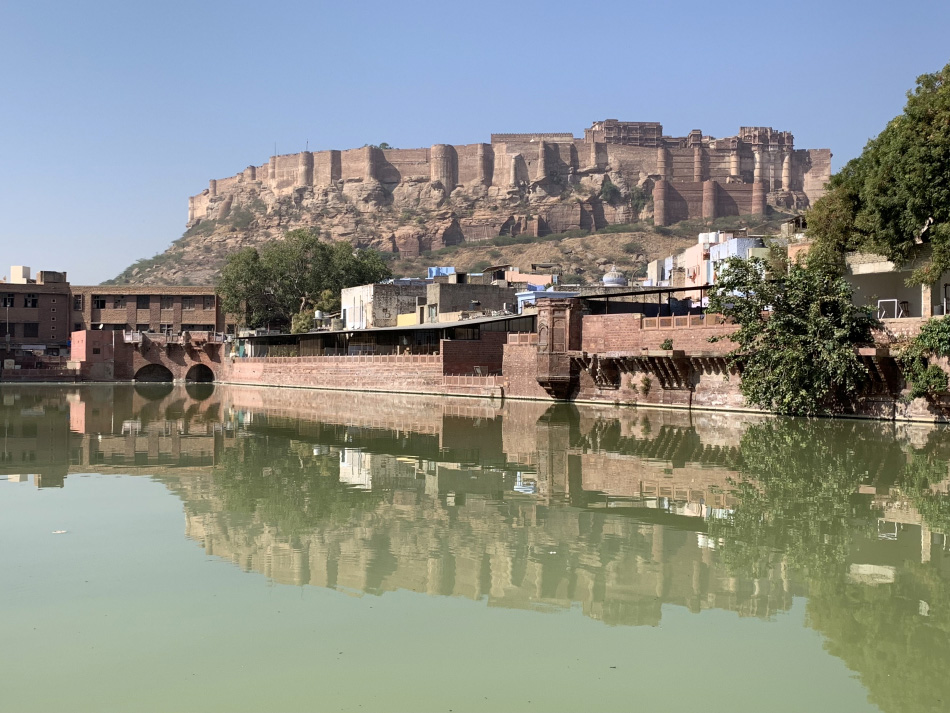 Across the street from Mahila Bagh Ka Jhalra, Gulab Sagar is a manmade reservoir measured 150m x 90m. It took 8 years to construct the reservoir, in which water from Balsamand Lake was transported to the reservoir via canals. For tourists, Gulab Sagar is one of the best places to photograph the reflection of the Mehrangarh Fort.
Across the street from Mahila Bagh Ka Jhalra, Gulab Sagar is a manmade reservoir measured 150m x 90m. It took 8 years to construct the reservoir, in which water from Balsamand Lake was transported to the reservoir via canals. For tourists, Gulab Sagar is one of the best places to photograph the reflection of the Mehrangarh Fort.
 In modern times, domestic and industrial effluents have been dumped into Gulab Sagar, raising the risk of water pollution.
In modern times, domestic and industrial effluents have been dumped into Gulab Sagar, raising the risk of water pollution.
 From the north side of Gulab Sagar, we found our way through lanes of blue houses towards our next stepwell Toorji Ka Jhalra.
From the north side of Gulab Sagar, we found our way through lanes of blue houses towards our next stepwell Toorji Ka Jhalra.
 Blue paint on red sandstone houses gives Jodhpur its unique visual identity.
Blue paint on red sandstone houses gives Jodhpur its unique visual identity.
 We also passed by beautiful haveli mansions erected in the bygone era.
We also passed by beautiful haveli mansions erected in the bygone era.
 Out of the 100+ stepwells in Jodhpur, Toorji Ka Jhalra is probably the most well known and frequently visited for tourists.
Out of the 100+ stepwells in Jodhpur, Toorji Ka Jhalra is probably the most well known and frequently visited for tourists.
 Built by Rani Toor Ji in the 1740s by a queen of Maharaja Abhay Singh, Toorji Ka Jhalra is another prominent historical stepwell near Gulab Sagar.
Built by Rani Toor Ji in the 1740s by a queen of Maharaja Abhay Singh, Toorji Ka Jhalra is another prominent historical stepwell near Gulab Sagar.
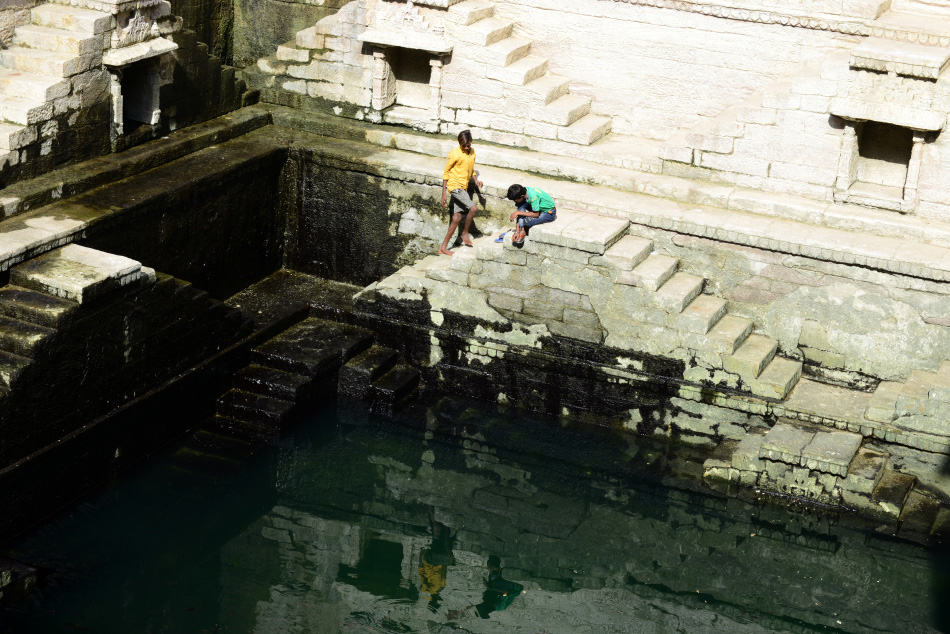 A few years ago, local hotels organized efforts to restore and clean up Toorji Ka Jhalra.
A few years ago, local hotels organized efforts to restore and clean up Toorji Ka Jhalra.
 Today, Toorji Ka Jhalra is widely seen as a success story of restoring a historical stepwell and maintaining acceptable water quality.
Today, Toorji Ka Jhalra is widely seen as a success story of restoring a historical stepwell and maintaining acceptable water quality.
 Water level at Toorji Ka Jhalra varies from season to season. The stepwell is over 200 feet deep.
Water level at Toorji Ka Jhalra varies from season to season. The stepwell is over 200 feet deep.
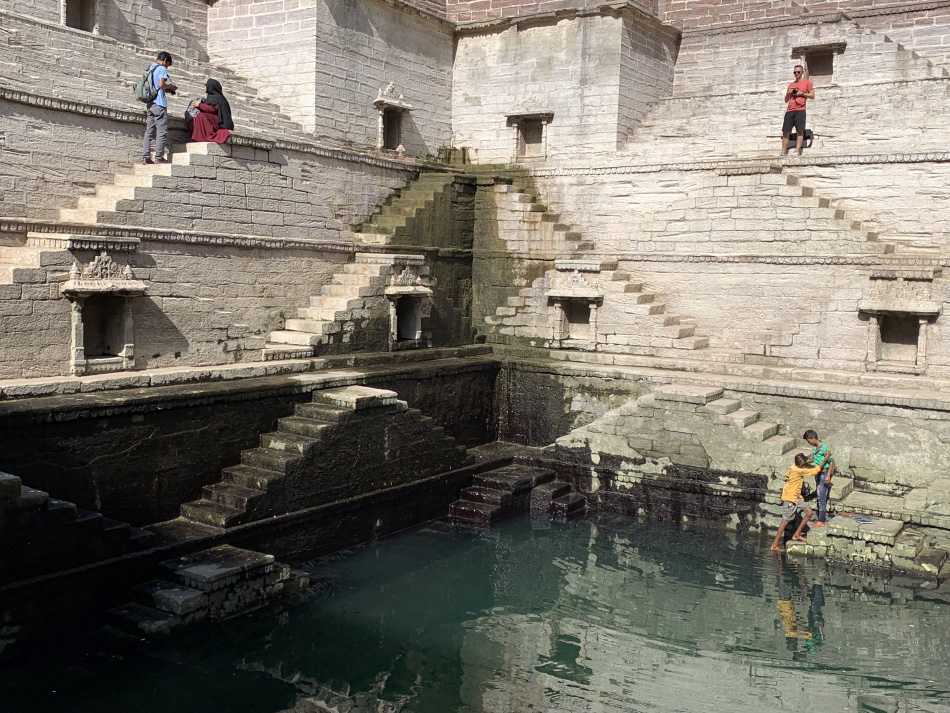 After restoration and cleaning, Toorji Ka Jhalra has become a magnet for locals and tourists. Many locals would take a dip into the water during the hottest hours of the day.
After restoration and cleaning, Toorji Ka Jhalra has become a magnet for locals and tourists. Many locals would take a dip into the water during the hottest hours of the day.
 The immediate area around Toorji Ka Jhalra is gradually revitalized with shops, cafes, restaurants, and hotels taking over restored heritage buildings.
The immediate area around Toorji Ka Jhalra is gradually revitalized with shops, cafes, restaurants, and hotels taking over restored heritage buildings.
 “JDH is an urban regeneration project that aims to restore the walled city of Jodhpur to its former glory, breathing new life into its invaluable landmarks and livelihoods.”
“JDH is an urban regeneration project that aims to restore the walled city of Jodhpur to its former glory, breathing new life into its invaluable landmarks and livelihoods.”
 After checking out the water bodies, we returned to Pal Haveli to have a quick bite at the rooftop restaurant.
After checking out the water bodies, we returned to Pal Haveli to have a quick bite at the rooftop restaurant.
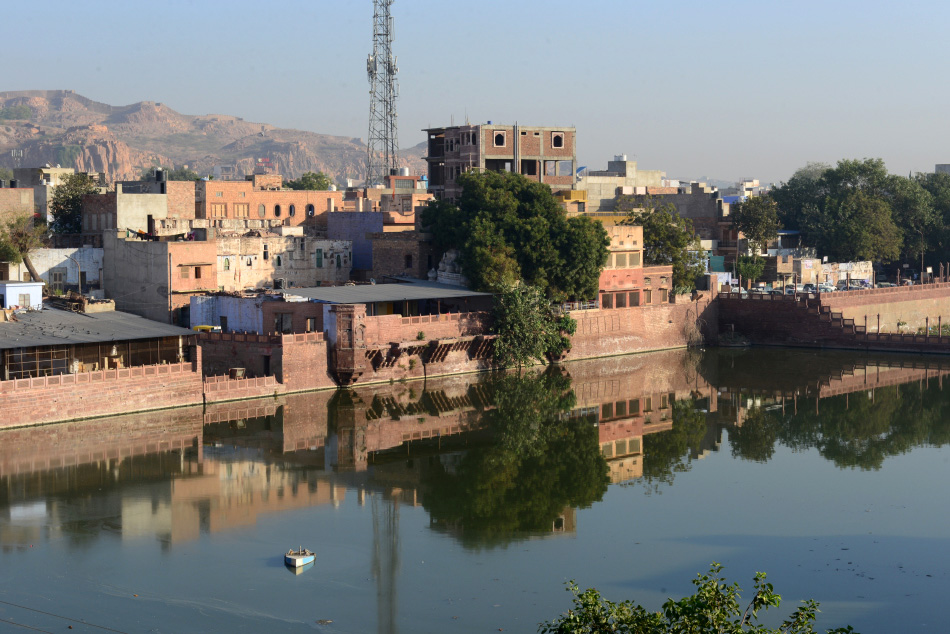 From the hotel rooftop, Gulab Sagar appeared to be calm and beautiful. Our hired car arrived at 13:00 for our ongoing journey over to Jaisalmer.
From the hotel rooftop, Gulab Sagar appeared to be calm and beautiful. Our hired car arrived at 13:00 for our ongoing journey over to Jaisalmer.
***
Posts on 2018 Rajasthan:-
Day 1: Jodhpur
DAY 1.1: IN TRANSIT TO RAJASTHAN
DAY 1.2: PAL HAVELI & THE OMELETTE MAN, Jodhpur
DAY 1.3: SPLENDOR OF THE SUN FORT, Mehrangarh, Jodhpur
DAY 1.4: SUNSET OVER THE BLUE CITY, Mehrangarh, Jodhpur
DAY 1.5: SADAR MARKET AND GHANTA GHAR CLOCKTOWER, Jodhpur
Day 2: Jodhpur, Osian, Jaisalmer
DAY 2.1: MARBLE CENOTAPH JASWANT THADA, Jodhpur
DAY 2.2: MEDIEVAL STEPWELLS, Mahila Bagh Ka Jhalra, Gulab Sagar, & Toorji Ka Jhalra, Jodhpur
DAY 2.3: PILGRIM OASIS IN THAR DESERT, Sachiya Mata Temple, Osian
DAY 2.4: SUNRISE AT THE FIRST GATE OF GOLDEN FORT, Jaisalmer
Day 3: Jaisalmer
DAY 3.1: THE GOLDEN LIVING FORT, Jaisalmer
DAY 3.2: JAIN TEMPLES PART 1, Jaisalmer
DAY 3.3: JAIN TEMPLES PART 2, Jaisalmer
DAY 3.4: FORT PALACE, Jaisalmer
Day 4: Jaisalmer
DAY 4.1: RESERVOIR OF THE GOLDEN CITY, Gadsisar Lake, Jaisalmer
DAY 4.2: ARCHITECTURAL JEWEL OF RAJASTHAN, Patwon Ki Haveli Part 1, Jaisalmer
DAY 4.3: ARCHITECTURAL JEWEL OF RAJASTHAN, Patwon Ki Haveli Part 2, Jaisalmer
DAY 4.4: DESERT HERITAGE, Hotel Nachana Haveli and Thar Heritage Museum, Jaisalmer
DAY 4.5: LAST STROLL IN THE GOLDEN CITY, Jaisalmer
Day 5: Pushkar
DAY 5.1: RANIKHET EXPRESS
DAY 5.2: 52 BATHING GHATS, Pushkar
DAY 5.3: SUNSET OVER SACRED WATER, Pushkar
Day 6: Pushkar & Jaipur
DAY 6.1: SUNRISE OVER PUSHKAR LAKE, Pushkar
DAY 6.2: GRANDEUR OF THE MAHARAJA, City Palace, Jaipur
DAY 6.3: IN SEARCH OF 1860 CARL ZEISS CAMERA, Jaipur
Day 7: Jaipur
DAY 7.1: AMBER FORT, Jaipur
DAY 7.2: JAIGARH FORT, Jaipur
DAY 7.3: MAHARAJA’S ASTRONOMICAL LEGACY, Jantar Mantar, Jaipur
DAY 7.4: PALACE OF WINDS, Hawa Mahal, Jaipur
Day 8: Bhangarh, Abhaneri & Agra
DAY 8.1: ON THR ROAD TO AGRA
DAY 8.2: HAUNTED RUINS, Bhangarh, Rajasthan
DAY 8.3: CHAND BAORI, Abhaneri, Rajasthan
DAY 8.4: THE ABANDONED CAPITAL OF MUGHAL EMPIRE, Fatehpur Sikri, Agra, Uttar Pradesh
DAY 8.5: FRIDAY MOSQUE, Fatehpur Sikri, Agra, Uttar Pradesh
Day 9: Agra
DAY 9.1: CROWN OF THE PALACES, Taj Mahal, Agra, Uttar Pradesh
DAY 9.2: AGRA FORT, Agra, Uttar Pradesh
DAY 9.3: RAWATPARA SPICE MARKET, Agra, Uttar Pradesh
DAY 9.4: SUNSET AT MEHTAB BAGH, Agra, Uttar Pradesh
Day 10: Delhi
DAY 10.1: TRAIN 12627, Agra to Delhi
DAY 10.2 : HUMAYUN’S TOMB, Delhi
Day 10.3: NIZAMUDDIN BASTI, Delhi
DAY 2 (1/4): MARBLE CENOTAPH JASWANT THADA, Jodhpur, Rajasthan, India, 2018.11.25

After settling ourselves from a terrifying incident with a stray dog near our hotel in early morning, we were ready to venture out again in Jodhpur for a few more hours before our hired car came pick us up to move on to Jaisalmer. Similar to our visit of Mehrangarh Fort the day before, our tuk tuk took us into the winding lanes north of Pal Haveli and climbed uphill until reaching a bronze equestrian statue of Rao Jodha, the founder of Jodhpur in the 15th century. We soon reached our first destination of the day, the magnificent marble monument of Jaswant Thada. Built in 1899 by Maharaja Sardar Singh, the Jaswant Thada is a cenotaph for Maharaja Jaswant Singh II and the cremation ground for the Marwar royal family.
 Standing adjacent to the Deity Pond in Rao Jodha Desert Rock Park, Jaswant Thada is surrounded by the arid landscape of Jodhpur.
Standing adjacent to the Deity Pond in Rao Jodha Desert Rock Park, Jaswant Thada is surrounded by the arid landscape of Jodhpur.
 From the parking lot, we entered into a garden right by Deity Pond. A short flight of steps led us to the main garden terrace.
From the parking lot, we entered into a garden right by Deity Pond. A short flight of steps led us to the main garden terrace.
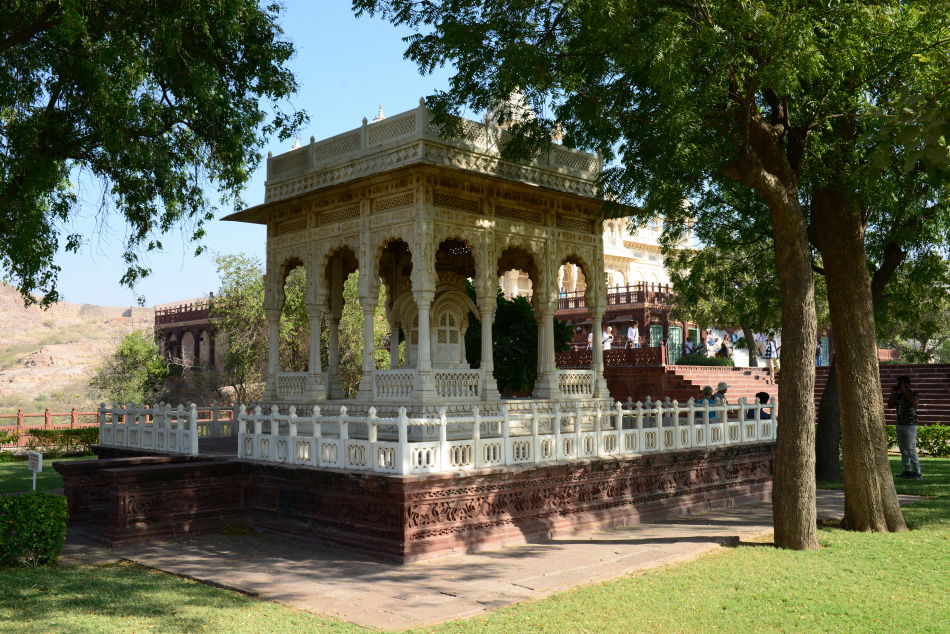 At the main garden terrace, the first thing we encountered was a beautiful gazebo.
At the main garden terrace, the first thing we encountered was a beautiful gazebo.
 As a delightful example of 19th century Rajasthani temple architecture, the Jaswant Thada is beautiful in many ways, from the finest ornaments to the overall architectural proportion. The row of chhatri (folly domes) on the roof signifies the wealth and status of the royal family.
As a delightful example of 19th century Rajasthani temple architecture, the Jaswant Thada is beautiful in many ways, from the finest ornaments to the overall architectural proportion. The row of chhatri (folly domes) on the roof signifies the wealth and status of the royal family.
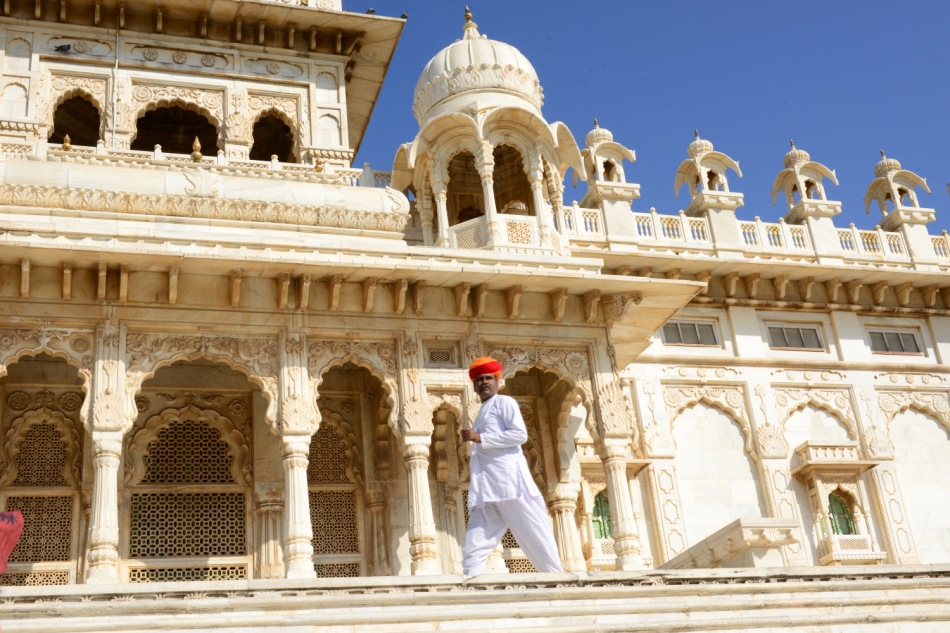 The mausoleum presents the splendid marble carving, especially the jali work (lattice) of the Indian craftsmen.
The mausoleum presents the splendid marble carving, especially the jali work (lattice) of the Indian craftsmen.
 Before entering the building, we took our time to examine the beautiful craftsmanship of the stonework and jali (lattice).
Before entering the building, we took our time to examine the beautiful craftsmanship of the stonework and jali (lattice).
 Visitors can enter the cenotaph through a side door.
Visitors can enter the cenotaph through a side door.
 No shoes are allowed in the cenotaph.
No shoes are allowed in the cenotaph.
 We were greatly attracted by the layers of marble carving.
We were greatly attracted by the layers of marble carving.
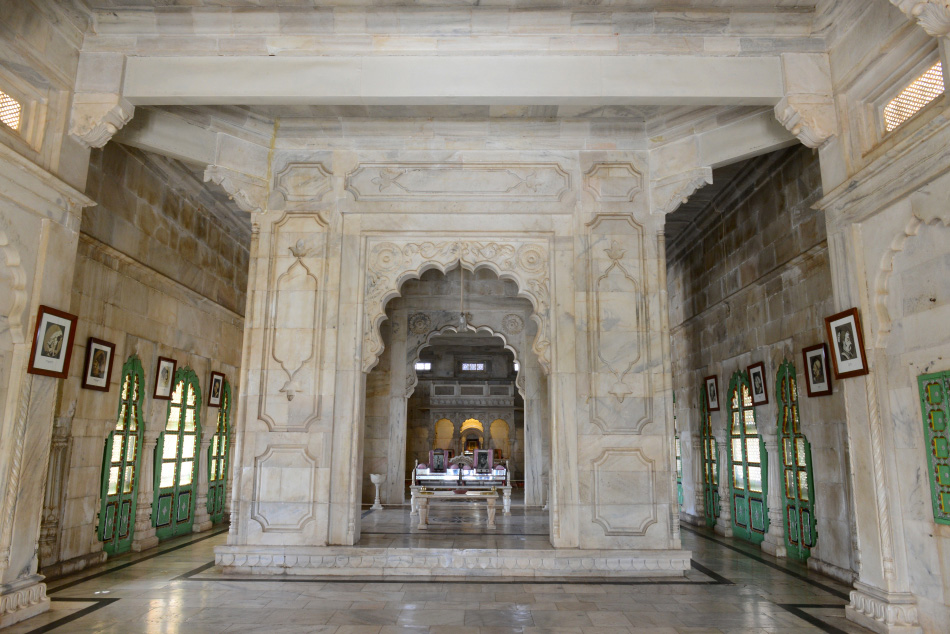 The interior featured photos and illustrations of the Marwar rulers, and memorial altar for Maharaja Jaswant Singh II.
The interior featured photos and illustrations of the Marwar rulers, and memorial altar for Maharaja Jaswant Singh II.
 We loved the fine jali work (stone lattice), which looked like paper art made by laser cutting.
We loved the fine jali work (stone lattice), which looked like paper art made by laser cutting.
 Natural light entered the building through the beautiful jali, providing a soft lighting effect for the interior.
Natural light entered the building through the beautiful jali, providing a soft lighting effect for the interior.
 Sunlight penetrated through the thin pieces of marble, creating an illumination effect on certain parts of the wall.
Sunlight penetrated through the thin pieces of marble, creating an illumination effect on certain parts of the wall.
 A vivid green is applied to the wooden doors and windows, creating a beautiful contrast to the colour palette of the architecture.
A vivid green is applied to the wooden doors and windows, creating a beautiful contrast to the colour palette of the architecture.
 On our way back to the parking lot, we passed by a traditional musician once again.
On our way back to the parking lot, we passed by a traditional musician once again.
 We stopped for a few minutes to admire the Rajasthani folk music before heading back to the parking lot.
We stopped for a few minutes to admire the Rajasthani folk music before heading back to the parking lot.
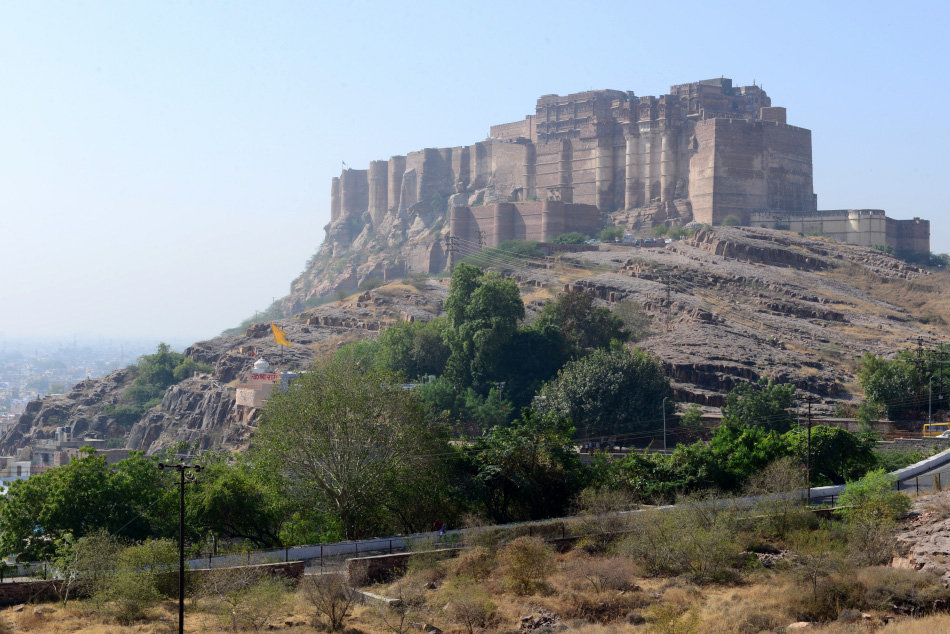 From the parking lot of Jaswant Thada, we had a final overview of the majestic Mehrangarh Fort.
From the parking lot of Jaswant Thada, we had a final overview of the majestic Mehrangarh Fort.
***
Posts on 2018 Rajasthan:-
Day 1: Jodhpur
DAY 1.1: IN TRANSIT TO RAJASTHAN
DAY 1.2: PAL HAVELI & THE OMELETTE MAN, Jodhpur
DAY 1.3: SPLENDOR OF THE SUN FORT, Mehrangarh, Jodhpur
DAY 1.4: SUNSET OVER THE BLUE CITY, Mehrangarh, Jodhpur
DAY 1.5: SADAR MARKET AND GHANTA GHAR CLOCKTOWER, Jodhpur
Day 2: Jodhpur, Osian, Jaisalmer
DAY 2.1: MARBLE CENOTAPH JASWANT THADA, Jodhpur
DAY 2.2: MEDIEVAL STEPWELLS, Mahila Bagh Ka Jhalra, Gulab Sagar, & Toorji Ka Jhalra, Jodhpur
DAY 2.3: PILGRIM OASIS IN THAR DESERT, Sachiya Mata Temple, Osian
DAY 2.4: SUNRISE AT THE FIRST GATE OF GOLDEN FORT, Jaisalmer
Day 3: Jaisalmer
DAY 3.1: THE GOLDEN LIVING FORT, Jaisalmer
DAY 3.2: JAIN TEMPLES PART 1, Jaisalmer
DAY 3.3: JAIN TEMPLES PART 2, Jaisalmer
DAY 3.4: FORT PALACE, Jaisalmer
Day 4: Jaisalmer
DAY 4.1: RESERVOIR OF THE GOLDEN CITY, Gadsisar Lake, Jaisalmer
DAY 4.2: ARCHITECTURAL JEWEL OF RAJASTHAN, Patwon Ki Haveli Part 1, Jaisalmer
DAY 4.3: ARCHITECTURAL JEWEL OF RAJASTHAN, Patwon Ki Haveli Part 2, Jaisalmer
DAY 4.4: DESERT HERITAGE, Hotel Nachana Haveli and Thar Heritage Museum, Jaisalmer
DAY 4.5: LAST STROLL IN THE GOLDEN CITY, Jaisalmer
Day 5: Pushkar
DAY 5.1: RANIKHET EXPRESS
DAY 5.2: 52 BATHING GHATS, Pushkar
DAY 5.3: SUNSET OVER SACRED WATER, Pushkar
Day 6: Pushkar & Jaipur
DAY 6.1: SUNRISE OVER PUSHKAR LAKE, Pushkar
DAY 6.2: GRANDEUR OF THE MAHARAJA, City Palace, Jaipur
DAY 6.3: IN SEARCH OF 1860 CARL ZEISS CAMERA, Jaipur
Day 7: Jaipur
DAY 7.1: AMBER FORT, Jaipur
DAY 7.2: JAIGARH FORT, Jaipur
DAY 7.3: MAHARAJA’S ASTRONOMICAL LEGACY, Jantar Mantar, Jaipur
DAY 7.4: PALACE OF WINDS, Hawa Mahal, Jaipur
Day 8: Bhangarh, Abhaneri & Agra
DAY 8.1: ON THR ROAD TO AGRA
DAY 8.2: HAUNTED RUINS, Bhangarh, Rajasthan
DAY 8.3: CHAND BAORI, Abhaneri, Rajasthan
DAY 8.4: THE ABANDONED CAPITAL OF MUGHAL EMPIRE, Fatehpur Sikri, Agra, Uttar Pradesh
DAY 8.5: FRIDAY MOSQUE, Fatehpur Sikri, Agra, Uttar Pradesh
Day 9: Agra
DAY 9.1: CROWN OF THE PALACES, Taj Mahal, Agra, Uttar Pradesh
DAY 9.2: AGRA FORT, Agra, Uttar Pradesh
DAY 9.3: RAWATPARA SPICE MARKET, Agra, Uttar Pradesh
DAY 9.4: SUNSET AT MEHTAB BAGH, Agra, Uttar Pradesh
Day 10: Delhi
DAY 10.1: TRAIN 12627, Agra to Delhi
DAY 10.2 : HUMAYUN’S TOMB, Delhi
Day 10.3: NIZAMUDDIN BASTI, Delhi
DAY 1 (5/5): SADAR MARKET AND GHANTA GHAR CLOCKTOWER, Jodhpur, Rajasthan, India, 2018.11.24

It was dark by the time we left Mehrangarh Fort. We turned our gaze from the fort to the cityscape below us. We saw countless festive lights flickering in different parts of the old city, as if a citywide party awaited for our return. At the centre of Old Jodhpur, the Ghanta Ghar Clock Tower was bathed in colourful lighting like a rainbow popsicle. We followed a winding footpath going downhill, hoping to get back to the old town in time for dinner at the rooftop restaurant at Pal Haveli. Before supper, we still had one more destination to go which was the vibrant Sadar Market at the Ghanta Ghar Clock Tower.
 It was getting dark when we began to walk down from Mehrangarh Fort. From afar, the clock tower in colourful lights was highly visible and served as a destination landmark to guide us for the walk.
It was getting dark when we began to walk down from Mehrangarh Fort. From afar, the clock tower in colourful lights was highly visible and served as a destination landmark to guide us for the walk.
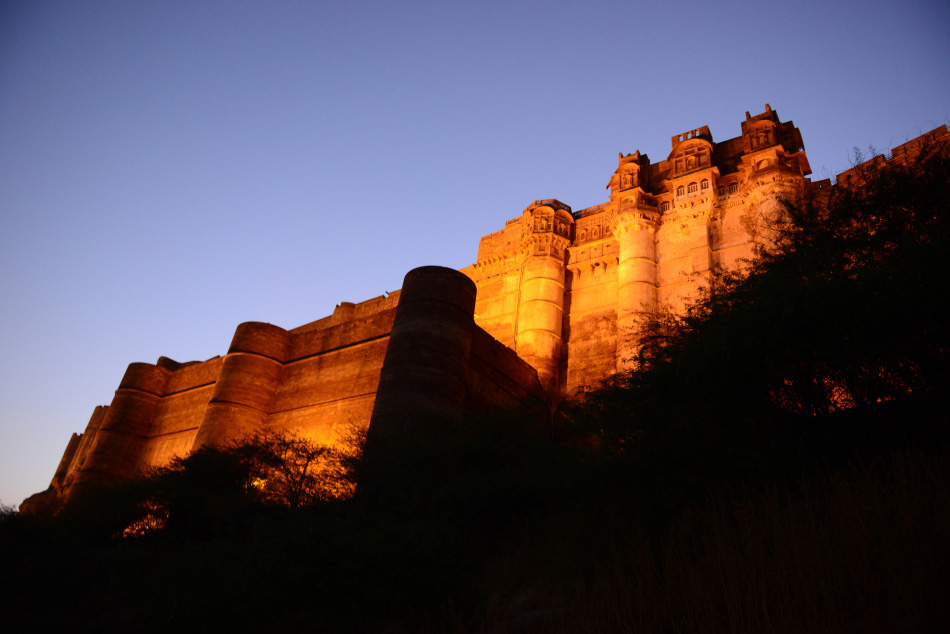 Mehrangarh Fort looked majestic under the evening flood lights.
Mehrangarh Fort looked majestic under the evening flood lights.
 The path soon led us into small streets at the foothills below the fort.
The path soon led us into small streets at the foothills below the fort.
 It was dinner time and most shops were about to close.
It was dinner time and most shops were about to close.
 We walked by many homes with their doors kept opened. From time to time, we could hear laughter of families from inside their homes.
We walked by many homes with their doors kept opened. From time to time, we could hear laughter of families from inside their homes.
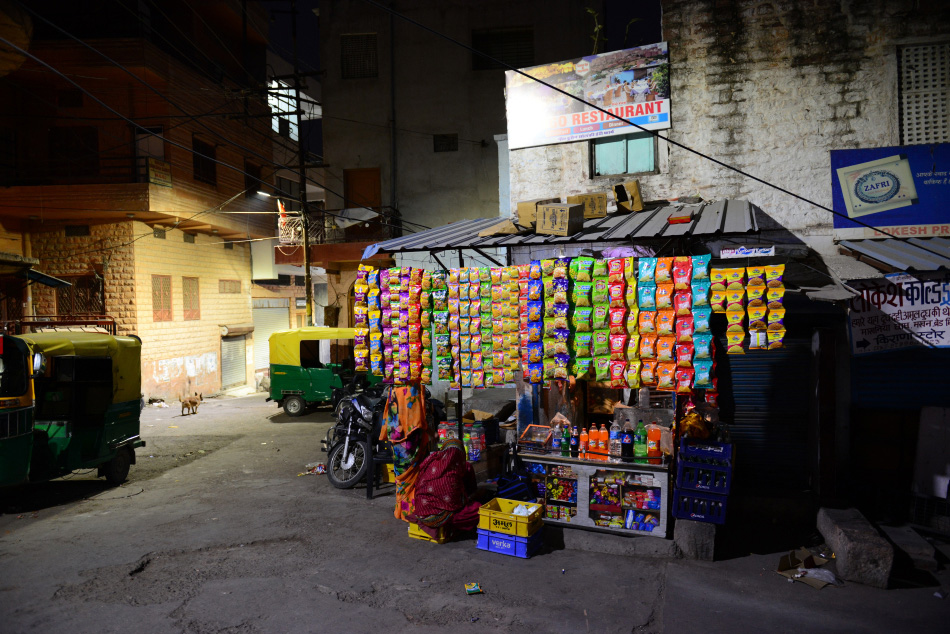 In Jodhpur, there was a common way in which the street vendors decorate their store with bags of chips and snacks in different colourful packaging hanging vertically around the front edge of the roof. It was very eye-catching.
In Jodhpur, there was a common way in which the street vendors decorate their store with bags of chips and snacks in different colourful packaging hanging vertically around the front edge of the roof. It was very eye-catching.
 We kept on walking downhill and hoped that we would soon reach the Sadar Market and Ghanta Ghar Clock Tower. Behind us, the massive Mehrangarh Fort provided a mysterious background.
We kept on walking downhill and hoped that we would soon reach the Sadar Market and Ghanta Ghar Clock Tower. Behind us, the massive Mehrangarh Fort provided a mysterious background.
 Soon we reached the bottom of the hill in the streets of Gulab Sagar,
Soon we reached the bottom of the hill in the streets of Gulab Sagar,
 It was dinner time for many families, and even bedtime for this puppy on a motorbike.
It was dinner time for many families, and even bedtime for this puppy on a motorbike.
 Near Sadar Market or Clock Tower Market, we passed by a small Hindu shrine along the main commercial street.
Near Sadar Market or Clock Tower Market, we passed by a small Hindu shrine along the main commercial street.
 A beautiful gateway welcomed us into the vibrant Sadar Market. The market was named after Maharaja Sardar Singh, who built the market and the clock tower during his reign from 1880 to 1911.
A beautiful gateway welcomed us into the vibrant Sadar Market. The market was named after Maharaja Sardar Singh, who built the market and the clock tower during his reign from 1880 to 1911.
 Built by Maharaja Sardar Singh in the late 19th century, the Ghanta Ghar Clock Tower is one the most iconic monuments of old Jodhpur.
Built by Maharaja Sardar Singh in the late 19th century, the Ghanta Ghar Clock Tower is one the most iconic monuments of old Jodhpur.
 Sadar Market is one of the busiest place in Jodhpur where locals and tourists come to shop for handicrafts, souvenirs, spices, fresh produce, textiles, jewellery and clothing.
Sadar Market is one of the busiest place in Jodhpur where locals and tourists come to shop for handicrafts, souvenirs, spices, fresh produce, textiles, jewellery and clothing.
 At Sadar Market, our target was to check out MV Spices Shop.
At Sadar Market, our target was to check out MV Spices Shop.
 Established by Mohan Lal Verhomal years ago, MV Spices is a renowned spices shop recommended by many guidebooks and foreign media. Today, the spices shop is managed by the friendly daughters of Mohan Lal Verhomal. After a cup of chai tea and a good chat with one of the daughters, we bought a pack of Maharaja curry, and also spices to make chai tea and chicken tikka masala.
Established by Mohan Lal Verhomal years ago, MV Spices is a renowned spices shop recommended by many guidebooks and foreign media. Today, the spices shop is managed by the friendly daughters of Mohan Lal Verhomal. After a cup of chai tea and a good chat with one of the daughters, we bought a pack of Maharaja curry, and also spices to make chai tea and chicken tikka masala.
 After a quick visit of Sadar Market, we returned to our hotel Pal Haveli.
After a quick visit of Sadar Market, we returned to our hotel Pal Haveli.
 We climbed up to the hotel’s rooftop restaurant Indique for dinner.
We climbed up to the hotel’s rooftop restaurant Indique for dinner.
 Indique is a popular rooftop restaurant in Old Jodhpur, serving decent Indian food with magnificent views of the old city.
Indique is a popular rooftop restaurant in Old Jodhpur, serving decent Indian food with magnificent views of the old city.
 We enjoyed the distant view of Mehrangarh Fort at one side of the rooftop. During dinner, it was a surprise to see a small firework in front of the fort. It came in a split second. We couldn’t react quick enough to capture the moment with our camera. The scene could only live in our memory.
We enjoyed the distant view of Mehrangarh Fort at one side of the rooftop. During dinner, it was a surprise to see a small firework in front of the fort. It came in a split second. We couldn’t react quick enough to capture the moment with our camera. The scene could only live in our memory.
 At the other side of the rooftop restaurant, we could look down to the vibrant Sadar Market and the colourful Ghanta Ghar Clock Tower.
At the other side of the rooftop restaurant, we could look down to the vibrant Sadar Market and the colourful Ghanta Ghar Clock Tower.
***
Posts on 2018 Rajasthan:-
Day 1: Jodhpur
DAY 1.1: IN TRANSIT TO RAJASTHAN
DAY 1.2: PAL HAVELI & THE OMELETTE MAN, Jodhpur
DAY 1.3: SPLENDOR OF THE SUN FORT, Mehrangarh, Jodhpur
DAY 1.4: SUNSET OVER THE BLUE CITY, Mehrangarh, Jodhpur
DAY 1.5: SADAR MARKET AND GHANTA GHAR CLOCKTOWER, Jodhpur
Day 2: Jodhpur, Osian, Jaisalmer
DAY 2.1: MARBLE CENOTAPH JASWANT THADA, Jodhpur
DAY 2.2: MEDIEVAL STEPWELLS, Mahila Bagh Ka Jhalra, Gulab Sagar, & Toorji Ka Jhalra, Jodhpur
DAY 2.3: PILGRIM OASIS IN THAR DESERT, Sachiya Mata Temple, Osian
DAY 2.4: SUNRISE AT THE FIRST GATE OF GOLDEN FORT, Jaisalmer
Day 3: Jaisalmer
DAY 3.1: THE GOLDEN LIVING FORT, Jaisalmer
DAY 3.2: JAIN TEMPLES PART 1, Jaisalmer
DAY 3.3: JAIN TEMPLES PART 2, Jaisalmer
DAY 3.4: FORT PALACE, Jaisalmer
Day 4: Jaisalmer
DAY 4.1: RESERVOIR OF THE GOLDEN CITY, Gadsisar Lake, Jaisalmer
DAY 4.2: ARCHITECTURAL JEWEL OF RAJASTHAN, Patwon Ki Haveli Part 1, Jaisalmer
DAY 4.3: ARCHITECTURAL JEWEL OF RAJASTHAN, Patwon Ki Haveli Part 2, Jaisalmer
DAY 4.4: DESERT HERITAGE, Hotel Nachana Haveli and Thar Heritage Museum, Jaisalmer
DAY 4.5: LAST STROLL IN THE GOLDEN CITY, Jaisalmer
Day 5: Pushkar
DAY 5.1: RANIKHET EXPRESS
DAY 5.2: 52 BATHING GHATS, Pushkar
DAY 5.3: SUNSET OVER SACRED WATER, Pushkar
Day 6: Pushkar & Jaipur
DAY 6.1: SUNRISE OVER PUSHKAR LAKE, Pushkar
DAY 6.2: GRANDEUR OF THE MAHARAJA, City Palace, Jaipur
DAY 6.3: IN SEARCH OF 1860 CARL ZEISS CAMERA, Jaipur
Day 7: Jaipur
DAY 7.1: AMBER FORT, Jaipur
DAY 7.2: JAIGARH FORT, Jaipur
DAY 7.3: MAHARAJA’S ASTRONOMICAL LEGACY, Jantar Mantar, Jaipur
DAY 7.4: PALACE OF WINDS, Hawa Mahal, Jaipur
Day 8: Bhangarh, Abhaneri & Agra
DAY 8.1: ON THR ROAD TO AGRA
DAY 8.2: HAUNTED RUINS, Bhangarh, Rajasthan
DAY 8.3: CHAND BAORI, Abhaneri, Rajasthan
DAY 8.4: THE ABANDONED CAPITAL OF MUGHAL EMPIRE, Fatehpur Sikri, Agra, Uttar Pradesh
DAY 8.5: FRIDAY MOSQUE, Fatehpur Sikri, Agra, Uttar Pradesh
Day 9: Agra
DAY 9.1: CROWN OF THE PALACES, Taj Mahal, Agra, Uttar Pradesh
DAY 9.2: AGRA FORT, Agra, Uttar Pradesh
DAY 9.3: RAWATPARA SPICE MARKET, Agra, Uttar Pradesh
DAY 9.4: SUNSET AT MEHTAB BAGH, Agra, Uttar Pradesh
Day 10: Delhi
DAY 10.1: TRAIN 12627, Agra to Delhi
DAY 10.2 : HUMAYUN’S TOMB, Delhi
Day 10.3: NIZAMUDDIN BASTI, Delhi
DAY 1 (4/5): SUNSET OVER THE BLUE CITY, Mehrangarh, Jodhpur, Rajasthan, India, 2018.11.24

After touring the museum and palaces of Mehrangarh, we followed the local visitors and walked over to the outer fortress. Time was perfect to view the sunset over the blue city of Jodhpur. Over at the far side of the fort we headed towards the 15th century Chamunda Mataji Temple, a small white structure frequented by locals. The fortress rampart led us toward the temple. From the wall, the views down to the famous blue city were breathtaking. Some said the blue paint on the walls was meant to keep the house interior cool and mosquito free. Through an arrowslit, we watched the sun descending slowly over the Thar Desert beyond Jodhpur.
Groups after groups of local visitors headed for the Chamunda Mataji Temple at the southern tip of the fort. The white temple stood peacefully under the sun’s orange glow. With such a beautiful scene, it was hard to imagine that a horrific stampede had happened right at this location back in 2008, with over 200 killed and hundreds injured. We didn’t find out about this tragic incident until we returned home. At that moment on the rampart of Mehrangarh Fort, we were totally absorbed in the splendid beauty of the blue city and the sinking sun.
 On our way to the fort rampart, a beautiful tree welcomed all visitors outside of the palace courtyard.
On our way to the fort rampart, a beautiful tree welcomed all visitors outside of the palace courtyard.
 A row of antique iron cannons stood silently on the fort rampart.
A row of antique iron cannons stood silently on the fort rampart.
 At the middle of the south rampart, abandoned houses and the top of the naturally hilltop.
At the middle of the south rampart, abandoned houses and the top of the naturally hilltop.
 The winding rampart led us all the way to Chamunda Mataji Temple.
The winding rampart led us all the way to Chamunda Mataji Temple.
 Looking down to the city, many areas in Old Jodhpur were dominated by blue houses.
Looking down to the city, many areas in Old Jodhpur were dominated by blue houses.
 The blue colour of the houses expressed a sense of relaxation and calmness.
The blue colour of the houses expressed a sense of relaxation and calmness.
 Soon we discovered the beautiful clock tower Ghanta Ghar at the market.
Soon we discovered the beautiful clock tower Ghanta Ghar at the market.
 Beyond the blue city, the grand Umaid Bhawan Palace stood against the horizon. Today, the building houses the residence of the Maharaja’s family, a museum and a world famous five-star hotel.
Beyond the blue city, the grand Umaid Bhawan Palace stood against the horizon. Today, the building houses the residence of the Maharaja’s family, a museum and a world famous five-star hotel.
 Occasional Hindu temples stood out from the sea of blue houses.
Occasional Hindu temples stood out from the sea of blue houses.
 The sun slowly descended toward the horizon.
The sun slowly descended toward the horizon.
 The sunset at Mehrangarh was one of the most beautiful sunset we had witnessed.
The sunset at Mehrangarh was one of the most beautiful sunset we had witnessed.
 The orange lights of the palace raised the beauty of Mehrangarh up to another level.
The orange lights of the palace raised the beauty of Mehrangarh up to another level.
 After sunset, we strolled around the complex a little more, and found our way to the main entrance of the fort.
After sunset, we strolled around the complex a little more, and found our way to the main entrance of the fort.
 We didn’t participate in the night tour, but stayed long enough to admire the palaces before darkness fell upon.
We didn’t participate in the night tour, but stayed long enough to admire the palaces before darkness fell upon.
 We slowly found ourselves out of the fort.
We slowly found ourselves out of the fort.
 It took us quite a while to return to the main gate of the fort.
It took us quite a while to return to the main gate of the fort.
 Such a romantic scene of Mehrangarh that comes straight out from the tales of the One Thousand and One Nights.
Such a romantic scene of Mehrangarh that comes straight out from the tales of the One Thousand and One Nights.
***
Posts on 2018 Rajasthan:-
Day 1: Jodhpur
DAY 1.1: IN TRANSIT TO RAJASTHAN
DAY 1.2: PAL HAVELI & THE OMELETTE MAN, Jodhpur
DAY 1.3: SPLENDOR OF THE SUN FORT, Mehrangarh, Jodhpur
DAY 1.4: SUNSET OVER THE BLUE CITY, Mehrangarh, Jodhpur
DAY 1.5: SADAR MARKET AND GHANTA GHAR CLOCKTOWER, Jodhpur
Day 2: Jodhpur, Osian, Jaisalmer
DAY 2.1: MARBLE CENOTAPH JASWANT THADA, Jodhpur
DAY 2.2: MEDIEVAL STEPWELLS, Mahila Bagh Ka Jhalra, Gulab Sagar, & Toorji Ka Jhalra, Jodhpur
DAY 2.3: PILGRIM OASIS IN THAR DESERT, Sachiya Mata Temple, Osian
DAY 2.4: SUNRISE AT THE FIRST GATE OF GOLDEN FORT, Jaisalmer
Day 3: Jaisalmer
DAY 3.1: THE GOLDEN LIVING FORT, Jaisalmer
DAY 3.2: JAIN TEMPLES PART 1, Jaisalmer
DAY 3.3: JAIN TEMPLES PART 2, Jaisalmer
DAY 3.4: FORT PALACE, Jaisalmer
Day 4: Jaisalmer
DAY 4.1: RESERVOIR OF THE GOLDEN CITY, Gadsisar Lake, Jaisalmer
DAY 4.2: ARCHITECTURAL JEWEL OF RAJASTHAN, Patwon Ki Haveli Part 1, Jaisalmer
DAY 4.3: ARCHITECTURAL JEWEL OF RAJASTHAN, Patwon Ki Haveli Part 2, Jaisalmer
DAY 4.4: DESERT HERITAGE, Hotel Nachana Haveli and Thar Heritage Museum, Jaisalmer
DAY 4.5: LAST STROLL IN THE GOLDEN CITY, Jaisalmer
Day 5: Pushkar
DAY 5.1: RANIKHET EXPRESS
DAY 5.2: 52 BATHING GHATS, Pushkar
DAY 5.3: SUNSET OVER SACRED WATER, Pushkar
Day 6: Pushkar & Jaipur
DAY 6.1: SUNRISE OVER PUSHKAR LAKE, Pushkar
DAY 6.2: GRANDEUR OF THE MAHARAJA, City Palace, Jaipur
DAY 6.3: IN SEARCH OF 1860 CARL ZEISS CAMERA, Jaipur
Day 7: Jaipur
DAY 7.1: AMBER FORT, Jaipur
DAY 7.2: JAIGARH FORT, Jaipur
DAY 7.3: MAHARAJA’S ASTRONOMICAL LEGACY, Jantar Mantar, Jaipur
DAY 7.4: PALACE OF WINDS, Hawa Mahal, Jaipur
Day 8: Bhangarh, Abhaneri & Agra
DAY 8.1: ON THR ROAD TO AGRA
DAY 8.2: HAUNTED RUINS, Bhangarh, Rajasthan
DAY 8.3: CHAND BAORI, Abhaneri, Rajasthan
DAY 8.4: THE ABANDONED CAPITAL OF MUGHAL EMPIRE, Fatehpur Sikri, Agra, Uttar Pradesh
DAY 8.5: FRIDAY MOSQUE, Fatehpur Sikri, Agra, Uttar Pradesh
Day 9: Agra
DAY 9.1: CROWN OF THE PALACES, Taj Mahal, Agra, Uttar Pradesh
DAY 9.2: AGRA FORT, Agra, Uttar Pradesh
DAY 9.3: RAWATPARA SPICE MARKET, Agra, Uttar Pradesh
DAY 9.4: SUNSET AT MEHTAB BAGH, Agra, Uttar Pradesh
Day 10: Delhi
DAY 10.1: TRAIN 12627, Agra to Delhi
DAY 10.2 : HUMAYUN’S TOMB, Delhi
Day 10.3: NIZAMUDDIN BASTI, Delhi
DAY 1 (3/5): SPLENDOR OF THE SUN FORT, Mehrangarh, Jodhpur, Rajasthan, India, 2018.11.24

Standing on a rock hill 120m above the old city of Jodhpur, many consider Mehrangarh Fort the most impressive fortress in India. Director Christopher Nolan must have the same feeling when he chose to shoot a scene of The Dark Knight Rises here back in 2011. Built in the 15th century by Rao Jodha, the king of Mandore who found the city of Jodhpur, Mehrangarh has impressed spectators for centuries with its massive defense walls and exquisite palaces. Since 1971, maharajas and princes in India were deprived of their privileges and remuneration. Maharaja Gaj Singhji of Jodhpur has since then became a politician in the parliament. In 1972, he found the Mehrangarh Museum Trust to restore and maintain his famous fort. Throughout the years, they have done a decent job in restoring the fort and establishing a museum to showcase the artifacts of former royal family. The Mehrangarh was the first place to visit during our stay in Rajasthan. We spent the rest of the day at the fort. We took our time to wander around the fort and listen to the informative audio guide, which was included in the admission of foreign visitors.
 Built in the 19th century by Maharaja Man Singh, a chattri (umbrella dome on pillars) was a memorial of feudal lord Thakur Shyam Singh Chauhan welcome most visitors in front of the massive fort.
Built in the 19th century by Maharaja Man Singh, a chattri (umbrella dome on pillars) was a memorial of feudal lord Thakur Shyam Singh Chauhan welcome most visitors in front of the massive fort.
 The impressive Mehrangarh is one of the largest forts in India.
The impressive Mehrangarh is one of the largest forts in India.
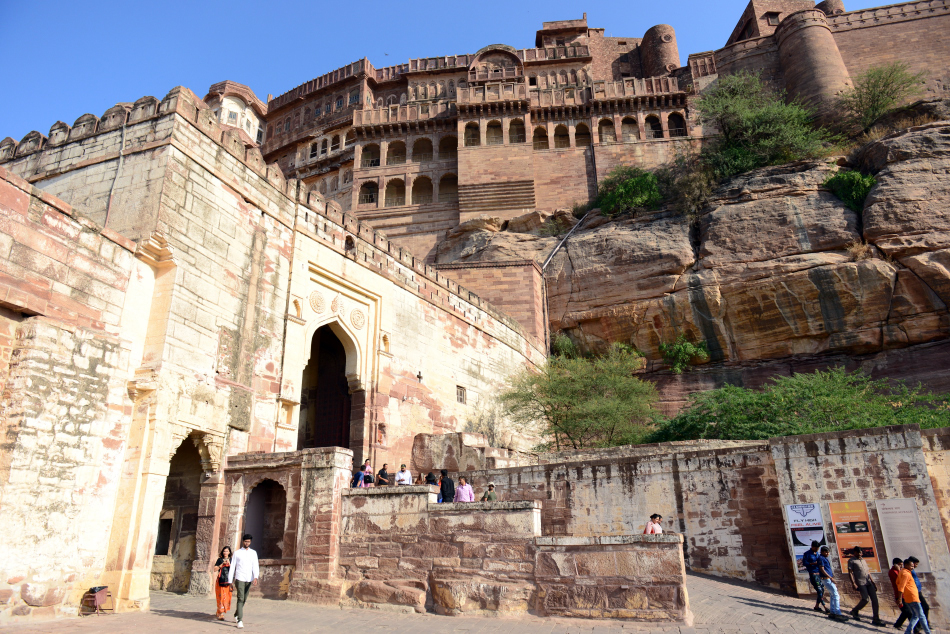 After entering the first gate Jai Pol, we soon arrived at the gates of Dodh Kangra Pol (left) and Imritia Pol (middle) on our way up to the fort.
After entering the first gate Jai Pol, we soon arrived at the gates of Dodh Kangra Pol (left) and Imritia Pol (middle) on our way up to the fort.
 Through the Imritia Pol, we followed other visitors and walked up to the next gate Loha Pol.
Through the Imritia Pol, we followed other visitors and walked up to the next gate Loha Pol.
 At the Loha Pol Gate, music performers rested in a niche along with their traditional drums and instruments.
At the Loha Pol Gate, music performers rested in a niche along with their traditional drums and instruments.
 At Loha Pol Gate, we walked by a series of small hand prints on the wall. Those small hand prints or the sati marks were left by the wives and concubines before their sati ritual. In the sati custom, these women would dressed in wedding finery and joined their husband in death on his funeral pyre.
At Loha Pol Gate, we walked by a series of small hand prints on the wall. Those small hand prints or the sati marks were left by the wives and concubines before their sati ritual. In the sati custom, these women would dressed in wedding finery and joined their husband in death on his funeral pyre.
 Beyond Loha Pol Gate, we entered a long courtyard where we had our first glimpse of the beautiful facades of Jhanki Mahal (Palace of Glimpses) and Phool Mahal (Palace of Flowers).
Beyond Loha Pol Gate, we entered a long courtyard where we had our first glimpse of the beautiful facades of Jhanki Mahal (Palace of Glimpses) and Phool Mahal (Palace of Flowers).
 Through the Suraj Pol or Sun Gate beyond a set of steps, we entered the Shringar Chowk Courtyard, the first part of the admission zone.
Through the Suraj Pol or Sun Gate beyond a set of steps, we entered the Shringar Chowk Courtyard, the first part of the admission zone.
 The Shringar Chowk Courtyard was the site of coronation for the maharajas.
The Shringar Chowk Courtyard was the site of coronation for the maharajas.
 At Shringar Chowk Courtyard, a staff was performing the act of opium smoking.
At Shringar Chowk Courtyard, a staff was performing the act of opium smoking.
 From Shringar Chowk, we entered the second courtyard known as Daulat Khana Chowk (Treasury Square). Constructed by Maharaja Ajit Singh in 1718, the second courtyard was the perfect spot to admire the splendid palaces of Mehrangarh: Daulat Khana Mahal (centre), Phool Mahal (right) and Jhanki Mahal (left).
From Shringar Chowk, we entered the second courtyard known as Daulat Khana Chowk (Treasury Square). Constructed by Maharaja Ajit Singh in 1718, the second courtyard was the perfect spot to admire the splendid palaces of Mehrangarh: Daulat Khana Mahal (centre), Phool Mahal (right) and Jhanki Mahal (left).
 The Daulat Khana Mahal (Treasury) showcases some fascinating artifacts of the royal family, including a collection of elephant’s howdahs, the wooden seat covered with gold and silver sheets fastened on the elephant backs for riding.
The Daulat Khana Mahal (Treasury) showcases some fascinating artifacts of the royal family, including a collection of elephant’s howdahs, the wooden seat covered with gold and silver sheets fastened on the elephant backs for riding.
 The display at the museum was full of wonderful display of paintings, artifacts and furniture of the royal family.
The display at the museum was full of wonderful display of paintings, artifacts and furniture of the royal family.
 The Phul Mahal or Palace of Flowers was a private reception hall constructed in the 18th century. It was used for private receptions or cozy music performances.
The Phul Mahal or Palace of Flowers was a private reception hall constructed in the 18th century. It was used for private receptions or cozy music performances.
 From Phul Mahal, we walked over to the roof of Daulat Khana Mahal, where we could look back down to the Daulat Khana Chowk (Treasury Square).
From Phul Mahal, we walked over to the roof of Daulat Khana Mahal, where we could look back down to the Daulat Khana Chowk (Treasury Square).
 Takhat Vilas was the private chamber of Takhat Singh in the 19th century. All surfaces were painted or decorated with colours. The Christmas balls were interesting additions to the interiors, at a time when Western influences came as trendy articulations in lives of the wealthy.
Takhat Vilas was the private chamber of Takhat Singh in the 19th century. All surfaces were painted or decorated with colours. The Christmas balls were interesting additions to the interiors, at a time when Western influences came as trendy articulations in lives of the wealthy.
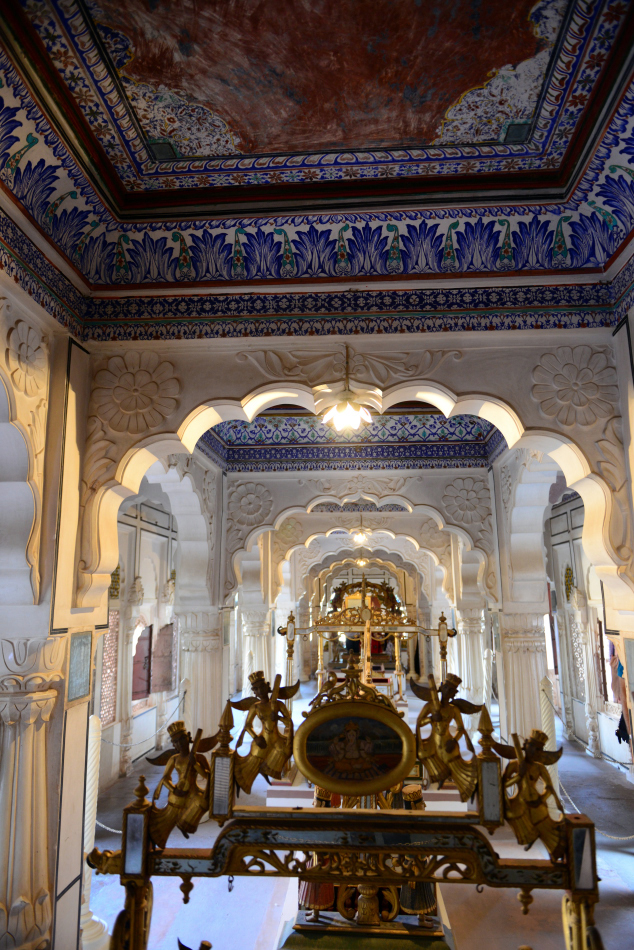 At Jhanki Mahal, a hallway was converted into the Cradle Gallery to display the facy cradles of the royal family, many of which were used for ceremonies during festivals.
At Jhanki Mahal, a hallway was converted into the Cradle Gallery to display the facy cradles of the royal family, many of which were used for ceremonies during festivals.
 From the upper floors in the palaces, we occasionally encountered great spots to look down to the blue city of old Jodhpur.
From the upper floors in the palaces, we occasionally encountered great spots to look down to the blue city of old Jodhpur.
 The Holi chowk courtyard was where the Maharaja and his wives and concubines celebrated important festivals.
The Holi chowk courtyard was where the Maharaja and his wives and concubines celebrated important festivals.
 With more than 250 stone latticework designs, the impressive building facades at Zenana Deorhi Chowk (Women’s Square) provided the perfect finale for the fortress visit.
With more than 250 stone latticework designs, the impressive building facades at Zenana Deorhi Chowk (Women’s Square) provided the perfect finale for the fortress visit.
***
Posts on 2018 Rajasthan:-
Day 1: Jodhpur
DAY 1.1: IN TRANSIT TO RAJASTHAN
DAY 1.2: PAL HAVELI & THE OMELETTE MAN, Jodhpur
DAY 1.3: SPLENDOR OF THE SUN FORT, Mehrangarh, Jodhpur
DAY 1.4: SUNSET OVER THE BLUE CITY, Mehrangarh, Jodhpur
DAY 1.5: SADAR MARKET AND GHANTA GHAR CLOCKTOWER, Jodhpur
Day 2: Jodhpur, Osian, Jaisalmer
DAY 2.1: MARBLE CENOTAPH JASWANT THADA, Jodhpur
DAY 2.2: MEDIEVAL STEPWELLS, Mahila Bagh Ka Jhalra, Gulab Sagar, & Toorji Ka Jhalra, Jodhpur
DAY 2.3: PILGRIM OASIS IN THAR DESERT, Sachiya Mata Temple, Osian
DAY 2.4: SUNRISE AT THE FIRST GATE OF GOLDEN FORT, Jaisalmer
Day 3: Jaisalmer
DAY 3.1: THE GOLDEN LIVING FORT, Jaisalmer
DAY 3.2: JAIN TEMPLES PART 1, Jaisalmer
DAY 3.3: JAIN TEMPLES PART 2, Jaisalmer
DAY 3.4: FORT PALACE, Jaisalmer
Day 4: Jaisalmer
DAY 4.1: RESERVOIR OF THE GOLDEN CITY, Gadsisar Lake, Jaisalmer
DAY 4.2: ARCHITECTURAL JEWEL OF RAJASTHAN, Patwon Ki Haveli Part 1, Jaisalmer
DAY 4.3: ARCHITECTURAL JEWEL OF RAJASTHAN, Patwon Ki Haveli Part 2, Jaisalmer
DAY 4.4: DESERT HERITAGE, Hotel Nachana Haveli and Thar Heritage Museum, Jaisalmer
DAY 4.5: LAST STROLL IN THE GOLDEN CITY, Jaisalmer
Day 5: Pushkar
DAY 5.1: RANIKHET EXPRESS
DAY 5.2: 52 BATHING GHATS, Pushkar
DAY 5.3: SUNSET OVER SACRED WATER, Pushkar
Day 6: Pushkar & Jaipur
DAY 6.1: SUNRISE OVER PUSHKAR LAKE, Pushkar
DAY 6.2: GRANDEUR OF THE MAHARAJA, City Palace, Jaipur
DAY 6.3: IN SEARCH OF 1860 CARL ZEISS CAMERA, Jaipur
Day 7: Jaipur
DAY 7.1: AMBER FORT, Jaipur
DAY 7.2: JAIGARH FORT, Jaipur
DAY 7.3: MAHARAJA’S ASTRONOMICAL LEGACY, Jantar Mantar, Jaipur
DAY 7.4: PALACE OF WINDS, Hawa Mahal, Jaipur
Day 8: Bhangarh, Abhaneri & Agra
DAY 8.1: ON THR ROAD TO AGRA
DAY 8.2: HAUNTED RUINS, Bhangarh, Rajasthan
DAY 8.3: CHAND BAORI, Abhaneri, Rajasthan
DAY 8.4: THE ABANDONED CAPITAL OF MUGHAL EMPIRE, Fatehpur Sikri, Agra, Uttar Pradesh
DAY 8.5: FRIDAY MOSQUE, Fatehpur Sikri, Agra, Uttar Pradesh
Day 9: Agra
DAY 9.1: CROWN OF THE PALACES, Taj Mahal, Agra, Uttar Pradesh
DAY 9.2: AGRA FORT, Agra, Uttar Pradesh
DAY 9.3: RAWATPARA SPICE MARKET, Agra, Uttar Pradesh
DAY 9.4: SUNSET AT MEHTAB BAGH, Agra, Uttar Pradesh
Day 10: Delhi
DAY 10.1: TRAIN 12627, Agra to Delhi
DAY 10.2 : HUMAYUN’S TOMB, Delhi
Day 10.3: NIZAMUDDIN BASTI, Delhi
DAY 1 (2/5): PAL HAVELI & THE OMELETTE MAN, Jodhpur, Rajasthan, India, 2018.11.24

Haveli in India refers to a large historical mansion built by a wealthy merchant over a century ago. Designed to impress both the residents and outside spectators, these buildings usually come with ornate carvings, beautiful frescoes, intricate window screens, and an airy courtyard or lightwell. While many have been fallen into disrepair over the years, some havelis have survived into modern times and become valuable heritage buildings. Rajasthan has some of the most famous and well preserved havelis in India, and some of which have been converted into museums or hotels. Situated in the old city near the Gulab Sagar Reservoir and Clock Tower Market, the beautiful Pal Haveli was our hotel in Jodhpur. Owned by the Pal Family, the two-hundred-year-old haveli was the place where we first experienced the historical sense and beauty of the Medieval Jodhpur. Antique housewares, paintings, textiles and furniture offered a charming ambience. From the rooftop restaurant, views of the busy Clock Tower Market and the majestic Mehrangart Fort were breathtaking. Outside the hotel, the market streets and square near the Clock Tower dominated the street scenes.
Just a stone throw away stood a simple omelette shop that has been frequented by foreign tourists ever since Lonely Planet named the local eatery as the famous “Omelette Shop” in 1999. Since then, this simple eatery has been elevated into legendary status among foreign tourists. The life of Ramkishan Gawlani the owner has been completely transformed ever since. According to an interview with Reuters, Ramkishan Gawlani was used to be poor and drank all day. For 24 years he cooked meat, rice, lentils and sometimes omelette. After Lonely Planet’s listing however, his business boomed dramatically with tourists all over the world come to him for omelettes. He gave up the other options in his menu and became an omelette specialist. Just a decade after the listing, he was cracking 1000 eggs a day and earned much respect in the city of Jodhpur. Interestingly, the famous omelette man is in fact a vegan and has not eaten an egg for years. His story reflects an interesting phenomenon about the tourist and guidebook industry. According to Reuters, Lonely Planet has sold over a million guidebooks on India from 1981 to 2007, and has inevitably bringing tourists to the same hotels and restaurants throughout the years, and has created tension and jealousy among businesses, such as the hostile feelings of the other omelette shop owners towards Ramkishan Gawlani. For us, we did visit the famous Omelette Shop for our first meal in Rajasthan because of its convenient location. While not as legendary one might imagine, Ramkishan Gawlani ‘s omelettes were indeed delightful and convenient for us.
 We arrived at Pal Haveli hotel straight from the airport in early afternoon.
We arrived at Pal Haveli hotel straight from the airport in early afternoon.
 Through the grand entrance, we entered into the main arrival courtyard of the hotel.
Through the grand entrance, we entered into the main arrival courtyard of the hotel.
 On the roof, Indique Restaurant is a well known establishment with good food and great views of the old Jodhpur.
On the roof, Indique Restaurant is a well known establishment with good food and great views of the old Jodhpur.
 The hotel reception lobby is situated right at the courtyard.
The hotel reception lobby is situated right at the courtyard.
 Despite its modest size, the reception lobby of Pal Haveli is decently decorated with traditional furniture and antiques.
Despite its modest size, the reception lobby of Pal Haveli is decently decorated with traditional furniture and antiques.
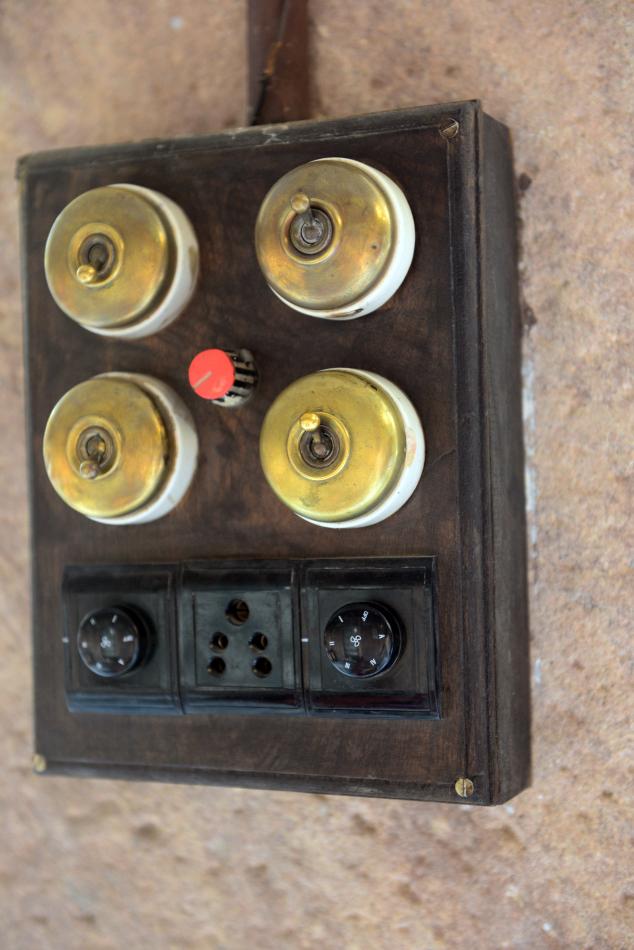 Even the light switches reflect the long history of the building.
Even the light switches reflect the long history of the building.
 Our room was located right by the courtyard.
Our room was located right by the courtyard.
 Inside the room, walls were decorated with traditional miniature paintings.
Inside the room, walls were decorated with traditional miniature paintings.
 Just a stone throw away, the legendary Omelette Shop was busy serving foreign tourists.
Just a stone throw away, the legendary Omelette Shop was busy serving foreign tourists.
 Stacks of eggs and signs of “Lonely Planet” and “Tripadvisor” suggested we had come to the “right” place, but not one of the imitated ones.
Stacks of eggs and signs of “Lonely Planet” and “Tripadvisor” suggested we had come to the “right” place, but not one of the imitated ones.
 Ramkishan Gawlaniwas busy making omelettes at the stove.
Ramkishan Gawlaniwas busy making omelettes at the stove.
 Made with several eggs, mayo, cheese, spices and bread, we tried the tasty Alibaba Omelette.
Made with several eggs, mayo, cheese, spices and bread, we tried the tasty Alibaba Omelette.
 Near the Omelette Shop was the entrance into the Sardar Market or the Clock Tower Market.
Near the Omelette Shop was the entrance into the Sardar Market or the Clock Tower Market.
 Across the street from the Omelette Shop, we could see the side facade of our hotel Pal Haveli.
Across the street from the Omelette Shop, we could see the side facade of our hotel Pal Haveli.
 Dozens of tuk tuks or auto rickshaws await for tourists at the heart of the old city across the street from the Omelette Shop.
Dozens of tuk tuks or auto rickshaws await for tourists at the heart of the old city across the street from the Omelette Shop.
 After a few rounds of bargaining, we hired one of the passing auto rickshaw for Mehrangarh Fort, the single most iconic sight of the city of Jodhpur.
After a few rounds of bargaining, we hired one of the passing auto rickshaw for Mehrangarh Fort, the single most iconic sight of the city of Jodhpur.
***
Posts on 2018 Rajasthan:-
Day 1: Jodhpur
DAY 1.1: IN TRANSIT TO RAJASTHAN
DAY 1.2: PAL HAVELI & THE OMELETTE MAN, Jodhpur
DAY 1.3: SPLENDOR OF THE SUN FORT, Mehrangarh, Jodhpur
DAY 1.4: SUNSET OVER THE BLUE CITY, Mehrangarh, Jodhpur
DAY 1.5: SADAR MARKET AND GHANTA GHAR CLOCKTOWER, Jodhpur
Day 2: Jodhpur, Osian, Jaisalmer
DAY 2.1: MARBLE CENOTAPH JASWANT THADA, Jodhpur
DAY 2.2: MEDIEVAL STEPWELLS, Mahila Bagh Ka Jhalra, Gulab Sagar, & Toorji Ka Jhalra, Jodhpur
DAY 2.3: PILGRIM OASIS IN THAR DESERT, Sachiya Mata Temple, Osian
DAY 2.4: SUNRISE AT THE FIRST GATE OF GOLDEN FORT, Jaisalmer
Day 3: Jaisalmer
DAY 3.1: THE GOLDEN LIVING FORT, Jaisalmer
DAY 3.2: JAIN TEMPLES PART 1, Jaisalmer
DAY 3.3: JAIN TEMPLES PART 2, Jaisalmer
DAY 3.4: FORT PALACE, Jaisalmer
Day 4: Jaisalmer
DAY 4.1: RESERVOIR OF THE GOLDEN CITY, Gadsisar Lake, Jaisalmer
DAY 4.2: ARCHITECTURAL JEWEL OF RAJASTHAN, Patwon Ki Haveli Part 1, Jaisalmer
DAY 4.3: ARCHITECTURAL JEWEL OF RAJASTHAN, Patwon Ki Haveli Part 2, Jaisalmer
DAY 4.4: DESERT HERITAGE, Hotel Nachana Haveli and Thar Heritage Museum, Jaisalmer
DAY 4.5: LAST STROLL IN THE GOLDEN CITY, Jaisalmer
Day 5: Pushkar
DAY 5.1: RANIKHET EXPRESS
DAY 5.2: 52 BATHING GHATS, Pushkar
DAY 5.3: SUNSET OVER SACRED WATER, Pushkar
Day 6: Pushkar & Jaipur
DAY 6.1: SUNRISE OVER PUSHKAR LAKE, Pushkar
DAY 6.2: GRANDEUR OF THE MAHARAJA, City Palace, Jaipur
DAY 6.3: IN SEARCH OF 1860 CARL ZEISS CAMERA, Jaipur
Day 7: Jaipur
DAY 7.1: AMBER FORT, Jaipur
DAY 7.2: JAIGARH FORT, Jaipur
DAY 7.3: MAHARAJA’S ASTRONOMICAL LEGACY, Jantar Mantar, Jaipur
DAY 7.4: PALACE OF WINDS, Hawa Mahal, Jaipur
Day 8: Bhangarh, Abhaneri & Agra
DAY 8.1: ON THR ROAD TO AGRA
DAY 8.2: HAUNTED RUINS, Bhangarh, Rajasthan
DAY 8.3: CHAND BAORI, Abhaneri, Rajasthan
DAY 8.4: THE ABANDONED CAPITAL OF MUGHAL EMPIRE, Fatehpur Sikri, Agra, Uttar Pradesh
DAY 8.5: FRIDAY MOSQUE, Fatehpur Sikri, Agra, Uttar Pradesh
Day 9: Agra
DAY 9.1: CROWN OF THE PALACES, Taj Mahal, Agra, Uttar Pradesh
DAY 9.2: AGRA FORT, Agra, Uttar Pradesh
DAY 9.3: RAWATPARA SPICE MARKET, Agra, Uttar Pradesh
DAY 9.4: SUNSET AT MEHTAB BAGH, Agra, Uttar Pradesh
Day 10: Delhi
DAY 10.1: TRAIN 12627, Agra to Delhi
DAY 10.2 : HUMAYUN’S TOMB, Delhi
Day 10.3: NIZAMUDDIN BASTI, Delhi
